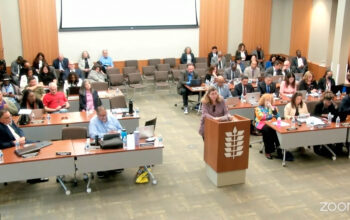Pierce College President Alexis Montevirgen announced Thursday that departments could restore their original fall allocations, reversing course on a proposal to cut 3-5 percent of classes due to an annual budget deficit that one estimate puts at $3 million.
The change came after rumblings that the Faculty Guild Executive Board on campus, led by Pierce College Chapter President Brian Walsh, and the department chairs of Pierce College were going to protest.
After the Departmental Council meeting on Tuesday, Feb. 11, when the deficit and cuts were being discussed, Vice President of Academic Affairs Sheri Berger sent out an email to the department chairs explaining two different potential plans.
Plan A explained what a straight across the board 4.9% cut would look like for each department down to the allocated hours and schedule reductions. Plan B was a mildly softer alternative of a 3.2% cut, a total of 174 hours from the schedule compared to 272.8 hours in Plan A.
The department chairs were not pleased with either of the plans presented.
Walsh cited the college as projecting a $3.8 million deficit, but he said that the district is projecting the deficit is a much higher number than that, somewhere around $5.6 million.
“For one, I do not believe these numbers. I think this premise is a fallacy,” Walsh said. “I am saying this because this seems to be very cyclical, meaning every six years or so it seems to be another college’s turn at the bottom of the barrel.”
Prior to the current deficit Pierce College is facing, the campus ran a surplus every year from 2006 until 2019.
Walsh said he believes the district is sitting on $147 million and that there is a 20% reserve that they are not giving to the colleges in need.
“As much as the district likes to talk a good game, they do not back it up at all,” Walsh said. “The public pays for this school, and if the public found out that the money was just being sat on, they would be outraged. People don’t pay taxes for it to just be held on to. I mean what are they doing at the district, rolling around in it?”
Walsh believes that Pierce, along with its sister colleges, need to avoid dividing any further and that is why the Union is perfect to take the lead on challenging the district to take action in helping out their college proactively.
“We have been fighting this battle for years now, and in fact, the union fought for a change in the debt relief plan at the district budget committee which is being mysteriously held up,” said Walsh. “The break-down of trust between faculty and district officials is incredible … we never get a straight answer.”
Along with the Union, department chairs were also in outrage over the news of the deficit affecting fall allocations.
Psychology/Statistics Chair Maria Perser recalled the last major budget cut that Pierce underwent in 2008 during the Great Recession, and how they “decimated” the schedule of classes.
“We had 15-to-20 students per class that were trying to add a class, and it was just so heartbreaking. It took us so many years to recover from that, so it is scary to think about,” Perser said. “What is interesting when you look at these particular sheets that they gave us for the expenses, there is no detail.”
Perser said Pierce is supposed to now be funded by the new Student Success Funding Formula, and that state has already dispersed that money to the district and that is a part of this pot of money that the district is holding on to.
“This is unacceptable. The district needs to give the colleges the money that they are owed because they are not supposed to just hold on to money. They are not in the business of making money, and it is going to take all of us to stand up and say this is not okay,” Perser said.
Communications Chair Yeprem Davoodian said it’s not easy trying to change the schedule now.
“As a department chair, I look at these situations from a departmental standpoint, a student success standpoint and an access standpoint for the campus. When we do our scheduling we try to make a range of courses that fit student’s schedules, and the problem that arises when we have to cut classes is now I have to decide which areas I can take from and that is never easy,” Davoodian said.
Sheri Berger relayed via email that based on his meetings with the District Office, Pierce will be able to use additional Student Centered Funding Formula funding that is anticipated on arriving this month from the State for the fall allocations so that departments may use their original schedules.
“I am very glad that we were able to do so quickly, and that we didn’t have to go through with it,” Montevirgen said. “We will still have to look at ways to trim in other places, but at least not with the classes.
In Monday’s academic senate meeting, First Vice President of Academic Policy Michael Gend, voiced that each of the divisions and areas on campus may have had different concerns with vice presidents over the years, but he personally has lost faith in the system. He referred to the recent departmental council meeting, when Berger announced the proposed cut in classes during the last few minutes of the meeting.
“I’m just speaking as one single individual right now and I’m bracing for the retaliation that is going to ensue,” Gend said. “I do not have confidence in Rolf Schleicher, I do not have confidence in Earic Dixon-Peters, I do not have confidence in Sheri Berger, and last week my confidence in the president was very heavily shaken.”
Brian Walsh said the Faculty Guild Executive Board passed a resolution on colleges in debt in the district, which also passed the District Budget Committee.
“This is only the beginning. We can do amazing things when we all come together for a common purpose,” Walsh said. “We are going to push hard to not only get the Schools and Communities proposition on the ballot, but see it pass in November which will bring $12 billion more in state funding for education and community initiatives. We also must ask the question ‘20% for Whom?’ Why does the district sit on $147 million (20.4%) rather than spend that on the colleges? Why are they saving that money?”



